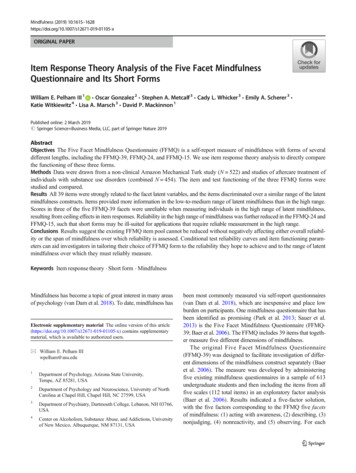
Transcription
Mindfulness (2019) 1105-xORIGINAL PAPERItem Response Theory Analysis of the Five Facet MindfulnessQuestionnaire and Its Short FormsWilliam E. Pelham III 1 & Oscar Gonzalez 2 & Stephen A. Metcalf 3 & Cady L. Whicker 3 & Emily A. Scherer 3 &Katie Witkiewitz 4 & Lisa A. Marsch 3 & David P. Mackinnon 1Published online: 2 March 2019# Springer Science Business Media, LLC, part of Springer Nature 2019AbstractObjectives The Five Facet Mindfulness Questionnaire (FFMQ) is a self-report measure of mindfulness with forms of severaldifferent lengths, including the FFMQ-39, FFMQ-24, and FFMQ-15. We use item response theory analysis to directly comparethe functioning of these three forms.Methods Data were drawn from a non-clinical Amazon Mechanical Turk study (N 522) and studies of aftercare treatment ofindividuals with substance use disorders (combined N 454). The item and test functioning of the three FFMQ forms werestudied and compared.Results All 39 items were strongly related to the facet latent variables, and the items discriminated over a similar range of the latentmindfulness constructs. Items provided more information in the low-to-medium range of latent mindfulness than in the high range.Scores in three of the five FFMQ-39 facets were unreliable when measuring individuals in the high range of latent mindfulness,resulting from ceiling effects in item responses. Reliability in the high range of mindfulness was further reduced in the FFMQ-24 andFFMQ-15, such that short forms may be ill-suited for applications that require reliable measurement in the high range.Conclusions Results suggest the existing FFMQ item pool cannot be reduced without negatively affecting either overall reliability or the span of mindfulness over which reliability is assessed. Conditional test reliability curves and item functioning parameters can aid investigators in tailoring their choice of FFMQ form to the reliability they hope to achieve and to the range of latentmindfulness over which they must reliably measure.Keywords Item response theory . Short form . MindfulnessMindfulness has become a topic of great interest in many areasof psychology (van Dam et al. 2018). To date, mindfulness hasElectronic supplementary material The online version of this ) contains supplementarymaterial, which is available to authorized users.* William E. Pelham IIIwpelham@asu.edu1Department of Psychology, Arizona State University,Tempe, AZ 85281, USA2Department of Psychology and Neuroscience, University of NorthCarolina at Chapel Hill, Chapel Hill, NC 27599, USA3Department of Psychiatry, Dartmouth College, Lebanon, NH 03766,USA4Center on Alcoholism, Substance Abuse, and Addictions, Universityof New Mexico, Albuquerque, NM 87131, USAbeen most commonly measured via self-report questionnaires(van Dam et al. 2018), which are inexpensive and place lowburden on participants. One mindfulness questionnaire that hasbeen identified as promising (Park et al. 2013; Sauer et al.2013) is the Five Facet Mindfulness Questionnaire (FFMQ39; Baer et al. 2006). The FFMQ includes 39 items that together measure five different dimensions of mindfulness.The original Five Facet Mindfulness Questionnaire(FFMQ-39) was designed to facilitate investigation of different dimensions of the mindfulness construct separately (Baeret al. 2006). The measure was developed by administeringfive existing mindfulness questionnaires in a sample of 613undergraduate students and then including the items from allfive scales (112 total items) in an exploratory factor analysis(Baer et al. 2006). Results indicated a five-factor solution,with the five factors corresponding to the FFMQ five facetsof mindfulness: (1) acting with awareness, (2) describing, (3)nonjudging, (4) nonreactivity, and (5) observing. For each
1616factor, the eight items with the highest loadings were retainedto form the FFMQ-39, which was then subjected to confirmatory factor analysis on a new sample. For the nonreactivityscale, only seven items with sufficiently high factor loadingswere identified, and hence, the total number of items is 39.Results indicated that a model with five correlated factors fitthe data well. The psychometric structure of the FFMQ hassince been replicated in many different samples (e.g.,Bohlmeijer et al. 2011; Christopher et al. 2012), and theFFMQ-39 has become one of the most popular self-reportmeasures of mindfulness.Unfortunately, the inclusion of 39 items limits the practicality of the FFMQ-39 for rapid or repeated administration.When asking participants to complete the FFMQ as part of anextensive battery of questionnaires or on a daily basis (e.g., forecological momentary assessment), investigators may preferan abbreviated item set that can approximate the completeform. The use of shorter forms can increase response ratesand response quality, but may also affect the reliability ofscores and the relation of scores with other criteria. At leastfive different short forms of the FFMQ have been created(Baer et al. 2012; Bohlmeijer et al. 2011; Hou et al. 2014;Medvedev et al. 2018; Tran et al. 2013). The two oldest andmost frequently used of these short forms are the FFMQ-15and the FFMQ-24.The FFMQ-15 (Baer et al. 2012) was originally created totrack weekly changes in mindfulness over the duration of an8-week course in mindfulness-based stress reduction. The investigators returned to data from the original FFMQ development (Baer et al. 2006) and retained for each facet the threeitems with the highest factor loadings in the exploratory factoranalysis. The authors did not report a detailed psychometricevaluation of the 15-item form, since it was not the primaryfocus of their study. Recently, the FFMQ-15 was evaluated ina sample of 238 participants with recurrent major depressivedisorder (Gu et al. 2016). Results indicated that the FFMQ-15exhibited psychometric structure, reliability, and sensitivity tochange similar to that of the FFMQ-39.The FFMQ-24 (Bohlmeijer et al. 2011) was created usingdata from samples recruited in the Netherlands. A group of 376adults with clinically relevant symptoms of depression and anxiety completed the full FFMQ-39. Items were then evaluated forhigh factor loadings, minimal cross-loadings, low residual errorcorrelations, and preserved content span (Marsh et al. 2005;Smith et al. 2000). Twenty-four items were chosen, and theresulting FFMQ-24 was validated on a separate sample of 146adults with self-reported fibromyalgia. Results indicated that theFFMQ-24 exhibited psychometric structure, reliability, and sensitivity to change similar to that of the FFMQ-39.Together, the FFMQ-39, FFMQ-24, and FFMQ-15 provideinvestigators three useful options for the measurement of selfreported mindfulness. However, there is limited informationto guide the choice among them, such as how much reliabilityMindfulness (2019) 10:1615–1628is sacrificed by dropping items, or how a score on either shortform is comparable to score on the complete form. We areaware of only one psychometric comparison of the FFMQ39 and the FFMQ-15 (Gu et al. 2016) and of no psychometriccomparison of the FFMQ-24 and the FFMQ-15.One approach that may help clarify the relative functioningof the FFMQ-39, FFMQ-24, and FFMQ-15 is item responsetheory (IRT). IRT comprises a family of latent variable modelsused to analyze discrete item responses and the resulting testscores. These models underlie many of the modern methodsfor scale development and high-stakes testing. Most psychologists are familiar with the methods of classical test theory forscale development and evaluation, such as test-total correlations, proportion endorsed on each item, and reliability coefficients (e.g., coefficient alpha). IRT complements classicaltest theory to permit comprehensive investigation of itemproperties, facilitate scale development by using item information functions, and enable the linkage of scores from participants who responded to different versions of the scale (deAyala 2009; Edelen and Reeve 2007; Embretson and Reise2000; Reise et al. 2005).A key property of IRT models is that the reliability (ormeasurement precision) of a score varies as a function of therespondent’s value on the latent construct being assessed. Thiscontrasts with classical test theory approaches, in which reliability is defined by a single number (e.g., coefficient alpha)that applies to every respondent’s score. In IRT, a score maybe more reliable for individuals that are in the high range ofthe latent variable (denoted theta, or θ, in the IRT framework)than for individuals that are in the low range of the latentvariable. When comparing forms of three different lengths(FFMQ-39, FFMQ-24, and FFMQ-15), an IRT analysiswould enable the comparison of not only whether but alsowhere the forms differ in score reliability. For example, itcould be that the FFMQ-15 produces scores with similar reliability to those of the FFMQ-39 for participants that are nearthe latent mean of nonreactivity, but produces substantiallyless reliable scores for respondents in the upper or lower extremes of nonreactivity. Such information could be used totailor the choice of FFMQ form to the specific research question and sample at hand.IRT analysis also yields richer understanding of item properties. Discrimination parameters indicate how strongly theitems relate to the latent variable being measured. Severity parameters indicate at what point along the latent variable continuum the items are differentiating respondents. These parameterscan be combined to yield an item information curve, or visualdepiction of how useful an item is in estimating test scoresacross the range of the latent construct. For example, it mightbe the case that item 3 of the FFMQ is only useful fordistinguishing individuals in the low range of nonjudging,whereas item 17 is only useful for distinguishing those in themid-to-high range of nonjudging. This type of information
Mindfulness (2019) 10:1615–1628could be used to improve the scale (e.g., by writing new itemsthat would be useful in a neglected range of the latent variable),to shorten the scale (e.g., by selecting a subset of items thatefficiently reproduces the properties of the full scale), or simplyto guide the scale’s effective use (e.g., by indicating over whatrange of the latent variable the scale scores are reliable). Insummary, item response theory analyses could provide valuableinformation about the absolute and relative psychometric properties of all three forms of the FFMQ.Despite the promise of an IRT approach, there have beenonly two previous IRT analyses of the FFMQ (Medvedevet al. 2017; Medvedev et al. 2018). Both analyses used Raschmodeling, a type of item response theory model in which thediscrimination parameters of all items are constrained to beequal (Embretson and Reise 2000). In practice, it is difficultfor all the items in a scale to meet this constraint, so part of aRasch analysis entails finding a subset of items that conforms tothe assumptions of the Rasch model (see Andrich 2004 for adiscussion of the philosophical and measurement issuessurrounding this practice). In the first study, Medvedev et al.(2017) conducted a Rasch analysis of the FFMQ-39 in a sampleof 296 university students and community members in NewZealand. Medvedev et al. modified the FFMQ as needed tosatisfy the Rasch assumptions, resulting in a new version: theFFMQ-37. The authors then provided tables to convert a totalscore on each facet of the FFMQ-37 into a more continuous,interval measurement scale. Second, Medvedev et al. (2018)applied the same Rasch procedures to four different short forms,including the FFMQ-24 and FFMQ-15 (N 400, subsumingthe sample in Medvedev et al. 2017). After modifying eachscale as needed to satisfy the Rasch assumptions, the authorsdetermined that a modified version of the FFMQ-24, theFFMQ-18, exhibited the best psychometric properties. Thus,they recommend the use of their FFMQ-18 when choosingamong short forms and the use of their FFMQ-37 when maximum reliability is needed.These two studies (Medvedev et al. 2017, 2018) illustratethe potential of using the IRT to evaluate the FFMQ. Theirfindings yielded increased precision of measurement withoutany change to the original item response format, plus a shortershort form with superior psychometric functioning. However,these studies were limited in several ways. First, neither studyincluded a clinical sample, with which the FFMQ is commonly used (e.g., in trials of mindfulness-based stress reduction).Second, both studies produced and then evaluated modifiedversions of the FFMQ (i.e., the FFMQ-37 and FFMQ-18),rather than studying the properties of the existing forms investigators are already using. Third, the studies did not directlycompare the reliability and score recovery of existing long andshort forms, and thus provided limited guidance to investigators seeking to choose among them. Finally, due to its strictrequirements, the Rasch approach does not yield some of thebenefits of IRT discussed above, such as evaluation of how1617each item independently functions. A more flexible IRT analysis that compares existing forms as they are may complementthe work of Medvedev and colleagues in understanding thepsychometric functioning of the FFMQ.The purpose of the current study was to compare the functioning of the FFMQ-39, FFMQ-24, and FFMQ-15 using itemresponse theory analysis. Analyses were expected to clarifythe conditions under which an investigator might choose oneof these forms over the others. We studied the item and testfunctioning of each FFMQ facet and compared these properties across the 39-, 24-, and 15-item forms. Finally, we evaluated the consistency of findings across two large datasets:adults recruited via Amazon Mechanical Turk (N 522) andindividuals receiving aftercare treatment for substance usedisorder (N 456).MethodParticipantsPrimary Sample (MTurk) Five hundred twenty-two participantscompleted the FFMQ as part of a larger battery of questionnaires on Amazon Mechanical Turk (MTurk). The participantscompleted 21 different self-report measures of constructs related to self-regulation as part of a larger, multisite project aimingto develop an Bontology of measures of impulsivity, time perspective, grit, mindfulness, sensation seeking, willpower, andrelated concepts. Only responses passing quality checks wereretained for analysis (see Eisenberg et al. 2018 for a descriptionof these checks and of the larger study protocol). Participantswere adults between 20 and 59 years old who lived in the USA.Mean age was 34 years old (SD 8), 51% of participants werefemale, 86% of participants were Caucasian, and 44% of participants were at least college-educated. There were no missingdata on the FFMQ items.Replication Sample (Clinical) Two smaller, secondary samples were combined and used to replicate the findingsobserved on the primary sample. Both were drawn fromrandomized, controlled trials of mindfulness-based relapseprevention (Bowen et al. 2011) for individuals with substance use disorders. In each study, participants had recently completed inpatient or intensive outpatient treatment for substance use disorders and were randomizedto different aftercare conditions. The first sample(Bowen et al. 2009) comprised 168 adults who were randomized to mindfulness-based relapse prevention or treatment as usual with the following characteristics: mean ageof 41 years old (SD 10), 64% male, 54% non-HispanicWhite, 30% African American, 15% Native American,5% Hispanic or Latino/a, 41% unemployed, and 72% having a high school degree. The second sample (Bowen
1618et al. 2014) comprised 286 adults who were randomizedto mindfulness-based relapse prevention, relapse prevention, or treatment as usual with the following characteristics: mean age of 38 years old (SD 11), 75% male, 53%non-Hispanic White, 25% African American, 6% NativeAmerican, 7% Hispanic or Latino/a, 66% unemployed,and 66% having a high school degree. Only data collectedat baseline (i.e., prior to randomization) are used in thisreport, so the participants had not yet been exposed to themindfulness-based intervention material that might be expected to affect their responses (Quaglia et al. 2016). Thetwo samples were combined to yield a sizeable validationdataset despite missing data. Most participants (324 of454 cases, or 71%) had complete data, with data missingsporadically across items (mean of 2.8% of item responses missing, maximum of 4.0%).ProceduresIn the primary sample (MTurk), participants completed theFFMQ online as one component of a larger battery of questionnaire and cognitive tasks measuring self-regulation(Eisenberg et al. 2018). The battery was delivered online viathe Experiment Factory platform (Sochat et al. 2016). In thesecondary sample (clinical), participants completed theFFMQ via a web-based survey platform (DatStat Illume,DatStat, Incorporated, Seattle, Washington) as part of thebaseline intake battery, prior to randomization to treatment(Bowen et al. 2009, 2014).MeasuresFFMQ-39 The FFMQ-39 (Baer et al. 2006) consists of 39 itemsasking the individual to rate the extent to which a statementpertaining to mindfulness is applicable, on a scale from 1(never or rarely true) to 5 (very often or always true).Nineteen of the 39 items are reverse-scored. These 19 itemswere reverse-scored prior to analysis, such that higher scoresindicate higher mindfulness throughout this manuscript.Table 1 lists the item prompts and provides descriptive statistics in the primary sample. Seven of the items comprise thenonreactivity facet, and eight items comprise each of the observing, describing, acting with awareness, and nonjudgingfacets. Total scores for each facet are computed by summingthe items after reverse scoring.FFMQ-24 and FFMQ-15 The FFMQ-15 (Baer et al. 2012) andFFMQ-24 (Bohlmeijer et al. 2011) were not administeredseparately from the FFMQ-39 in this study. Instead, responses on these two short forms were reconstructed basedon participants’ responses to the complete, 39-item form.Table 1 shows which items are included on both theFFMQ-24 and FFMQ-15.Mindfulness (2019) 10:1615–1628Data AnalysesAll analyses were conducted first on the primary dataset(MTurk) and second on the replication dataset (clinical). Themirt package in R (Chalmer 2012) was used for all modeling.Our basic procedure mimics that described in Edwards’(2009) introduction to IRT; we direct readers to that and thefollowing references for further background about IRT analysis and interpretation (de Ayala 2009; Edelen and Reeve 2007;Embretson and Reise 2000; Reise et al. 2005).Unidimensional IRT models were fit to each of the five facetsof the FFMQ-39 (Baer et al. 2006): acting with awareness,describing, nonjudging, nonreactivity, and observing. We analyzed item responses using the graded response model(GRM; Samejima 1969), which is appropriate for items withordered-categorical responses. The FFMQ items have fiveresponse options, so five item parameters were estimated foreach item: one slope parameter and four threshold parameters(often called Bseverity parameters; there are k 1 thresholdsfor an item with k categories). The slope parameter is analogous to a factor loading and indicates the strength of relationship between the item and the latent variable. An item with alarger slope parameter has a stronger relationship with thelatent variable and contributes more to the precise estimationof a participant’s value on the latent variable. The thresholdparameters correspond to the location of boundaries betweentwo response options on an item. Since each FFMQ item hasfive response options, there are four boundaries, and thus fourthreshold parameters per item. The thresholds are on the samemetric as the latent variable, so they can be interpreted asindicating at what value of the latent variable a participanthas a 50% chance of endorsing that response category or ahigher one. Lower threshold values indicate that the responsesto the corresponding item separate those at lower values of thelatent variable, and higher threshold values indicate that responses to the corresponding item separate those at highervalues of the latent variable. Taken together, the positioningof each item’s set of four thresholds indicates over what rangeof the latent variable that item is most useful.Item and Test Information Functions Slope and threshold parameters may be difficult to interpret in isolation. To ease interpretation, the estimated parameters from the FFMQ-39 can betransformed into item information functions that indicate overwhat range of the latent variable each item is most useful. Forexample, an item might provide more precise estimation forpeople below the mean of the mindfulness facet latent variablethan those above the mean. Item information functions are additive, so the test information function can be estimated to investigate the range of the latent variable in which the scale ismost useful. Test information functions were computed separately for the FFMQ-39, FFMQ-24, and FFMQ-15 by summing information from only the items present on each form.
Mindfulness (2019) 10:1615–1628Table 1Descriptive statistics for FFMQ items in primary sampleFacetActing withawarenessMean SDOnItem OnFFMQ- FFMQ152458131823DescribingNonjudging Nonreactivity3.423.863.523.823.78 28343827121622 27323731014 3.413.273.373.503.503.86172530 3.273.573.75 .823.65 3.423.183.243.16212429 3.403.023.1633 3.0516 2.843.2011 2.92 3.353.481520 2631 363.863.583.47% per response valueItem label1.08 0.06/0.15/0.27/0.37/0.15 When I do things, my mind wanders off and I am easily distracted0.96 0.01/0.07/0.25/0.38/0.29 I do not pay attention to what I am doing because I am daydreaming,worrying, or otherwise distracted1.10 0.05/0.13/0.26/0.36/0.20 I am easily distracted0.98 0.01/0.09/0.24/0.38/0.28 I find it difficult to stay focused on what’s happening in the present1.00 0.02/0.10/0.24/0.39/0.26 It seems I am ‘running on automatic’ without much awareness of what I amdoing0.90 0.01/0.05/0.21/0.39/0.35 I rush through activities without being really attentive to them0.94 0.01/0.07/0.28/0.38/0.27 I do jobs or tasks automatically without being aware of what I am doing0.98 0.02/0.07/0.23/0.39/0.29 I find myself doing things without paying attention1.10 0.05/0.14/0.28/0.34/0.19 I am good at finding words to describe my feelings1.02 0.02/0.11/0.26/0.38/0.23 I can easily put my beliefs, opinions, and expectations into words1.08 0.04/0.10/0.20/0.39/0.26 It’s hard for me to find the words to describe what I am thinking1.11 0.04/0.13/0.21/0.36/0.26 I have trouble thinking of the right words to express how I feel about things1.01 0.02/0.10/0.20/0.40/0.28 When I have a sensation in my body, it’s difficult for me to describe itbecause I cannot find the right words1.10 0.06/0.14/0.29/0.35/0.16 Even when I am feeling terribly upset, I can find a way to put it into words1.10 0.06/0.20/0.29/0.33/0.13 My natural tendency is to put my experiences into words1.14 0.07/0.16/0.27/0.34/0.16 I can usually describe how I feel at the moment in considerable detail1.18 0.06/0.15/0.25/0.31/0.24 I criticize myself for having irrational or inappropriate emotions1.06 0.03/0.15/0.30/0.33/0.19 I tell myself I should not be feeling the way I am feeling1.07 0.02/0.11/0.22/0.31/0.35 I believe some of my thoughts are abnormal or bad and I should not thinkthat way1.13 0.05/0.22/0.30/0.26/0.16 I make judgments about whether my thoughts are good or bad1.05 0.02/0.15/0.26/0.35/0.20 I tell myself that I should not be thinking the way I am thinking1.06 0.02/0.12/0.21/0.36/0.28 I think some of my emotions are bad or inappropriate and I should not feelthem1.09 0.02/0.15/0.28/0.28/0.28 When I have distressing thoughts or images, I judge myself as good or bad,depending what the thought or image is about1.14 0.04/0.20/0.27/0.28/0.21 I disapprove of myself when I have irrational ideas0.93 0.05/0.16/0.43/0.31/0.06 I perceive my feelings and emotions without having to react to them0.94 0.05/0.13/0.41/0.34/0.07 I watch my feelings without getting lost in them0.99 0.07/0.16/0.39/0.32/0.07 When I have distressing thoughts or images, I Bstep back and am aware ofthe thought or image without getting taken over by it0.94 0.03/0.12/0.37/0.37/0.11 In difficult situations, I can pause without immediately reacting1.00 0.08/0.21/0.38/0.29/0.05 When I have distressing thoughts or images, I feel calm soon after0.92 0.05/0.14/0.46/0.28/0.06 When I have distressing thoughts or images, I am able just to notice themwithout reacting0.96 0.07/0.18/0.45/0.25/0.06 When I have distressing thoughts or images, I just notice them and let themgo1.04 0.11/0.26/0.37/0.22/0.05 When I am walking, I deliberately notice the sensations of my body moving1.10 0.06/0.20/0.34/0.26/0.13 When I take a shower or bath, I stay alert to the sensations of water on mybody1.11 0.12/0.22/0.35/0.24/0.07 I notice how foods and drinks affect my thoughts, bodily sensations, andemotions1.02 0.04/0.14/0.36/0.32/0.13 I pay attention to sensations, such as the wind in my hair or sun on my face1.02 0.04/0.11/0.35/0.33/0.17 I pay attention to sounds, such as clocks ticking, birds chirping, or carspassing0.96 0.02/0.05/0.25/0.39/0.28 I notice the smells and aromas of things1.01 0.03/0.09/0.33/0.36/0.19 I notice visual elements in art or nature, such as colors, shapes, textures, orpatterns of light and shadow0.92 0.02/0.12/0.34/0.41/0.11 I pay attention to how my emotions affect my thoughts and behaviorB% per response value indicates the percentage of participants responding in the first, second, third, fourth, and fifth category on the response scale.Items were reverse-scored as indicated prior to calculating descriptive statistics. N 522 for all items
1620For example, there are only three items on the observing facetof the FFMQ-15. The item parameters estimated on the FFMQ39 (i.e., those in Table 2) for those three items were used toestimate a three-item test information function for the observingfacet of the FFMQ-15. Test information functions can be transformed into the standard error of measurement (SEM 1/ Information) and score precision, or reliability (Reliability 1 SEM2), so they can indicate over what range of the latentvariable the scale produces reliable scores.Score Linking When two scales contain overlapping items, thefactor scores they produce can be linked in the IRT framework. Summed scores on the FFMQ-39 observing facet(range 8–40) and on the FFMQ-15 observing facet (range 3–15) are not directly comparable (cf. Hambleton andSwaminathan 1985), but the constituent item responses canbe scored using the IRT item parameters to produce factorscores on the same scale (i.e., theta). Thus, score linking analyses can provide a sense of how well the FFMQ-24 andFFMQ-15 recover the latent facet scores that would have beenproduced using the full FFMQ-39, making scores across all ofthese forms comparable. To prevent overfitting, we split thesample in half, fit an IRT model to the FFMQ-39 facet in thefirst half of the sample, and then estimated expected aposteriori (EAP; Thissen and Wainer 2001) scores for boththe FFMQ-39 facet and the short-form facet in the second halfof the sample. We then calculated (a) the correlation of thefactor scores produced by the short-form facet with those produced by the FFMQ-39 facet and (b) the mean square error ofthe factor score of the short-form facet.ResultsWe report results from the primary sample first, and then compare them to results from the replication sample.Item FunctioningEstimated item slopes and thresholds are reported in Table 2.Fig. 1 shows the estimated slope parameters of each item.Across 39 items, slopes in the primary sample ranged from1.40 to 4.60 with a median value of 2.58, indicating positiveand reasonably strong associations of responses on the itemswith the latent variable. Slopes were lower on the nonreactivity(mean 1.96) and observing facets (mean 2.19) than on theother facets (means 3.23 [describing], 3.11 [nonjudging], and2.88 [acting with awareness]). The most discriminating itemson each facet were as follows: item number 38 for acting withawareness (BI find myself doing things without payingattention ), item number 7 for describing (BI can easily putmy beliefs, opinions, and expectations into words ), item number 30 for nonjudging (BI think some of my emotions are bad orMindfulness (2019) 10:1615–1628inappropriate and I shouldn’t feel them ), item number 29 fornonreactivity (BWhen I have distressing thoughts or images Iam able to just notice them without reacting ), and item number15 for observing (BI pay attention to sensations, such as thewind in my hair or sun on my face ).Figure 2 shows the estimated thresholds for each item.Across 39 items, thresholds ranged from 3.29 to 2.67, although most of the thresholds were negative or close to themean of the latent variable. The third thresholds (Bb3 ) weretypically close to the mean of the latent variable (indicated bythe vertical dashed line in Fig. 2). Thus, for most items, someone who is average on the latent facet of mindfulness will haveabout 50% probability of responding to positively valencedstatements with either often true (response value of 4) or verytrue/always true (response value of 5). In other words, manyof the items in the FFMQ-39 did not discriminate participantshigh on the facet of mindfulness. The nonreactivity facet wasthe only one to include multiple items with high ( 2 SDs)threshold values.Figure 3 (top row) displays the item information curves foreach of the five facets. Within each facet, the items conveyedinformation over a similar range of the latent variable, butvaried in the amount of information conveyed a
er measure five different dimensions of mindfulness. The original Five Facet Mindfulness Questionnaire (FFMQ-39) was designed to facilitate investigation of differ-ent dimensions of the mindfulness construct separately (Baer et al. 2006). The measure was developed by administering five existing mindfulness questionnaires in a sample of 613
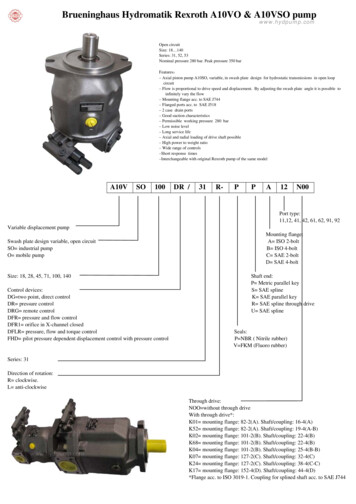
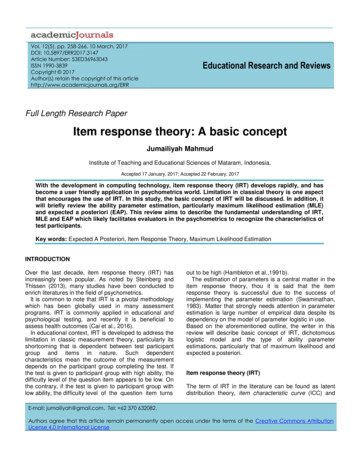

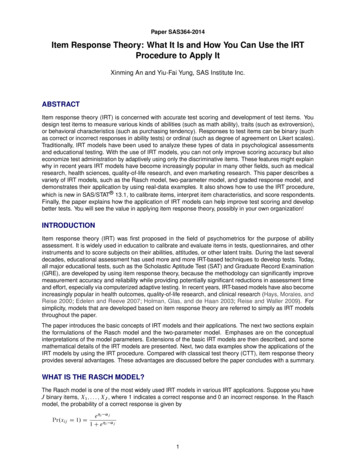

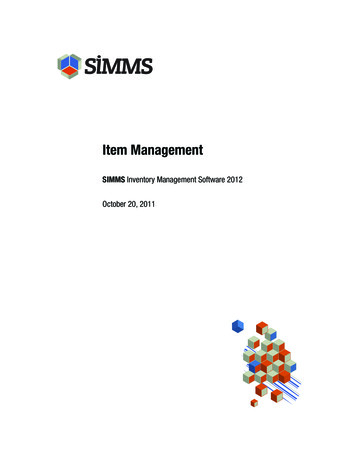
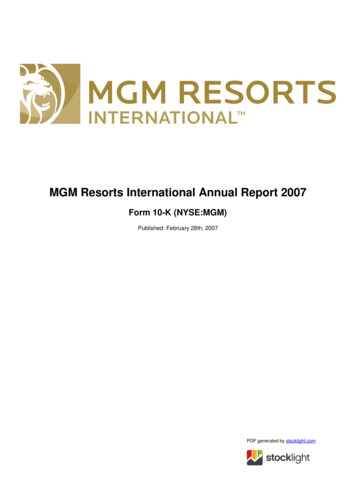
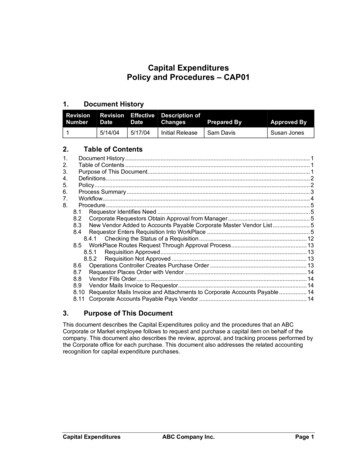
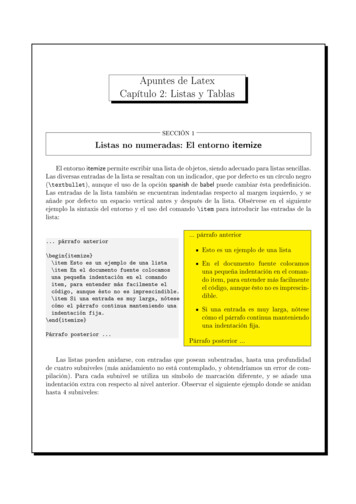
![[IRT] Item Response Theory - Stata](/img/54/irt.jpg)

